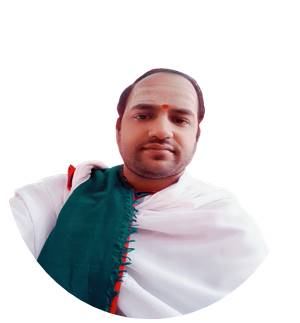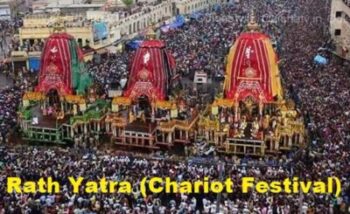Rath Yatra (Chariot Festival) of Lord Jagannath is one of the most prominent Yatra out of the 13 Yatra in Puri as per Skanda Purana & Niladri Mohadoya. According to Puran & Sastras, Shree Jagannath instructed King Indradyumna to celebrate all the yantras as per Ritus (seasons) and rules.
History of Rath Yatra (Chariot Festival)
The celebration of Ratha Yatra at Srimandir Puri is very old. The exact period details are not found in the Madala Panji.
Some scholars gave their opinion that in the period of King First Bhanudev there are six Rath used in the Rath Yatra but from the 13th century, the number of Rath for Chariot festival is 03.
Some other researchers gave their opinion that in the 08th or 09th century the Somabansi king Jajati Keshari started Rath yatra at Puri.
What is the period of Rath Yatra (Chariot Festival)?
The Rath yatra or chariot festival celebration is started in the Jagannath temple on Asadha Shukla Paskhya Dwitiya tithi and ends on Asadha Shukla Paskhya Dasami Tithi as per Srimandir Panji.
The world-famous Rath Yatra is celebrated for 9 days after a long stay of 15 days in the house of Ansar. On the day of the Rath Yatra, the Mahaprabhu Shree Jagannath, Lord Balabhadra, Sister Subhadra, and the celestial Wheel Sudarshan Bije in the chariots at Bada Danda to give their Darshan to the devotee’s worldwide.
Different Names of Rath Yatra
The Rath yatra is popularly known as Gudicha Yatra, Ghosh yatra, Niladri yatra, Bahuda Yatra, Car Festival, Chariot festival, etc. of Lord Jagannath.
This Yatra is the unique Yatra in the world in which the Supreme Power came out from his Ratna Singhasana to blessing human beings and also relieves them from their suffering.
In this festival all human beings can touch him and participate in the journey of the deities. The Lakhs of devotes participate in Ratha yatra and enjoying the ritual.
Important procedure & rules performed during Rath Yatra
- Pahandi
On the day of Rath yatra the deities brought from the Ranta Singhasan to the chariots with a spectacular royal procession called Pahandi Bije.
This Pahandi procession of the deities is in a row is known as ‘Dhadi Pahandi’. All the deities Pahandi started one by one with the accompaniment of the beat of cymbals, drums, and chanting of their names in chorus by devotees.
- Chera Pahara: It is performed by the Jagapati Maharaja of Puri. The Gajapati King cleanses all around the deities and Chariots with a gold-handled broom and sprinkles sandalwood water and powder with utmost devotion which is known as Chera Pahara.
- Rath Yatra: The devotees pulled the Chariots of deities from Srimandir to Gudicha Temple (Mausi Maa Temple) near about 3km. The deities Chariots are parked in front of the Gudicha temple. Then bathing and other rituals are performed.
- Entry in Gudicha Temple
On the next day evening, the deities are entering to the Gudicha Temple with the Procession of Goti Pahandi and Bije in their prescribed place.
The place where the deities are placed is known as Mahavedi or Janmavedi. The deities are remaining in Gudicha temple for 7 days.
- Hera Panchami
Hera Panchami is an important festival celebrated on the fifth day of the Ratha Yatra (Asada Sukla Sasthi). As per ritual on that day Goddess Laxmi visited Gundicha Temple to see the Lord Jagannath But the main doors of Gundicha temple are suddenly closed with a bang.
Then Goddess Laxmi returns with a heavy heart and in a fit of anger breaks a small part of the Nandighosa chariot (Rath of Shree Jagannath) and returns secretly to the main temple via Hera Gohri Sahi.
- Dakshina Moda
On the 6th day after Hera Panchami rituals, all the Chariots turn to the south which is known as Dakshina Moda. The Chariots are placed near Nakachana Dwara eastern Gate of Gundicha Temple towards Srimandir for the return journey.
There is a belief that the deities taken Dakshina Moda towards Srilanka to give their Darshan to Bibhisan (Ravan’s brother).
- Bahuda Yatra (Returning Journey)
The returning Journey of deities from Gudicha temple to Srimandir on the 9th day is called Bahuda Yatra.
- Laxminarayan Bheta
The Laxminarayan Bheta ritual is performed during Bahuda yatra when the Jagannath Chariot (Nandighosh) reached Marichikota near Srinagar.
- Suna Besha
This ritual was performed Asada Sukla Pashya Ekadasi Tithi after Madyanna Dhupa. The deities are decorated in gold ornaments on the chariots which are known as Suna Besha of Mahaprabhu.
- Adharpana
Adharpana ritual is performed on the next day of Suna Besha. As per the ritual, nine large open-mouth earthen pitchers full of drinks were placed touching the lips of the three deities.
The priests, through “Sodosha Upachar Puja’, offer the drink. Soon after, the pitchers smashed on the Raths for spilling the entire drink on the floors of the chariots.
It is believed that numerous ghosts, spirits trail the Lords during Rath Yatra waiting to consume the holy drink to get ‘moksha’ (Salvation).
- Niladri Bije
Niladri Bije is celebrated on Asada Trayodashi tithi and on that day the deities return to the Ranta Bedi. The Lord Jagannath offered Rasgulla to goddess Laxmi to enter into the temple. This is the end of the Rath yatra process.
How the Chariots are prepared for Rath Yatra
There are three Chariots built every year for the deities in the wood of trees like Phassi, Dhausa, Asana, Mahanimba, Gabhari, Kadamba, etc.
These woods come from Nayagarh, Khorda, Dasapala, Ranpur, etc. through Mahanadi river to Puri and it was transported from riverbank to Puri temple with Bullock-cart in ancient days but now it was transported through Trucks.
Total 1139 wood Logs are required for this festival and these are provided by the Forest Department of Govt. of Odisha.
The Chariot Anukula work is started from Saraswati Puja (Shree Panchami) and the wood Logs are cuts in the Sawmill on Sriram Navami. Jagya, Vedic Puja is performed for this auspicious work in front of Shreemandir.
Then on the Akshaya-Tritiya, the Chariot preparation work is started by the carpenters who are hereditary rights to build the chariots on the traditional method and completes it on the mid-day of Netra Ustav.
They have constructed three Chariots Such as Nandighosa, Taladhwaja & Darpadalana as per the rules of Slipasastra.
Rath (Chariots) Size & Structure
1. Nandighosa
Shree Jagannath Chariot is called Nandighosa. It is 45.6ft in height and the length & width are 34.6ft. There are 16 wheels in this Chariot with 6ft diameter.
The Chariot cover is made of red and yellow clothes. This Chariot is attached with four white color horses. Shree Jagannath and Modanmohan are Bije in this Chariot.
There are Nine Parsva Devata’s wooden images is painted on the Chariot sides. The name of these Devatas is:
- Harihar
- Pandu Nursinha
- Giri Govardhan Dhari
- Panchamukhi Mahavir
- Madhusudan
- Lakshman
- Narayan
- Ravan Chatrabhanga
- Chintamani Krusha
2. Taladhwaja
The Chariot of Lord Balabhadra is called Taladhwaja. It is 45ft in height and the length & width are 34.6ft. There are 14 wheels in this Chariot with a 6.6ft diameter.
The Chariot cover is made of red and blue clothes. This Chariot is attached with four Black color horses. Lord Balabhadra, Ram & Krushna is Bije in this Chariot.
There are Nine Parsva Devata’s wooden images is painted on the Chariot sides. The name of these Devatas is:
- Ramchandi
- Mangala
- Bimala
- Barahi
- Harachandi
- Bhadrakali
- Uma/Banadurga
- Kaptayani
- Aghora
3. Darpadalana
The Chariot of Goddess Subhadra is called Darpadalana. It is 44.6ft in height and the length & width are 31.6ft. There are 12 wheels in this Chariot with 6ft diameter.
The Chariot cover is made of red and black clothes. This Chariot is attached with four Red color horses. Devi Subhadra & Sudarshan is Bije in this Chariot.
There are Nine Parsva Devata’s wooden images is painted on the Chariot sides. The name of these Devatas is:
- Balaram
- Angada
- Sadanana Kartikeswar
- Natabar Ganesh
- Pralambari Mahadev
- Baisi Bhuja Nursingha
- Madhu Kaitabha
- Natambar
- Annata Basudev
Conclusion
The Rath Yatra is the oldest and most important Yatra of Shreekhatra. It is celebrated on Asadha Shukla Paskhya Dwitiya tithi and ends on Asadha Shukla Paskhya Dasami Tithi as per Srimandir Panji. This Chariot festival is celebrated all over the world. Lord Jagannath once in every year left the Ratna Devi with his brother Lord Balabhadra and sister Subhadra for nine days and give their Darshan to the devotee in Kaliyuga.
The following Sloka itself describes the benefit to shown Lord Jagannath in Rath Yatra.
Dole Cha Dolagobindang Chapesu Madhusudanam |
Rathetu Bamanam Drishta punarjanam Na Vidyate ||
ଦୋଳେ ଚ ଦୋଳଗୋବିନ୍ଦଂ ଚାପେସୁ ମଧୁସୂଦନମ |
ରଥେତୁ ବାମନଂ ଦୃଷ୍ଟା ପୁନର୍ଜନ୍ମ ନ ବିଦ୍ୟତେ ||
“Jay Jagannath”

Pandit Rashmi Ranjan Rath is a Vedic researcher and also recognized by the Lord Jagannath Temple administration, Puri as a “Shree Jagannath Sanskruti Pracharak” in the year 2013. He has visited four Dhams of India for creating Lord Jagannath consciousness Worldwide. He is also the founder of “Baidika Brahamana Parisada Odisha”.
